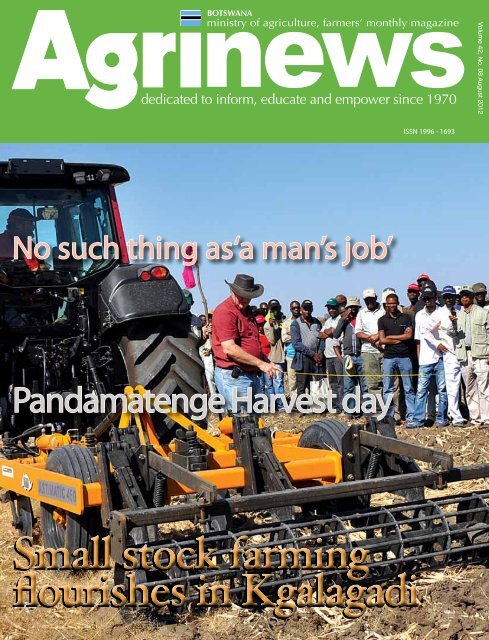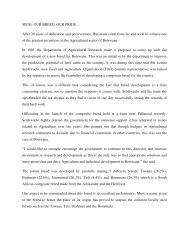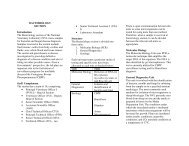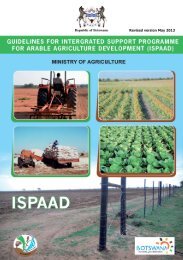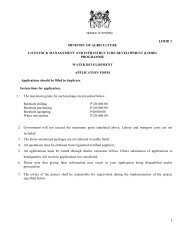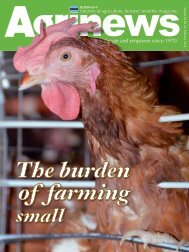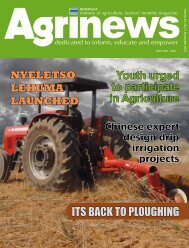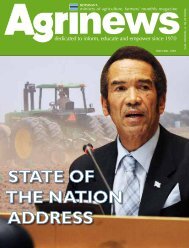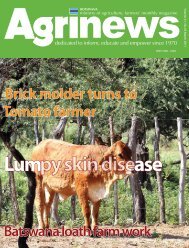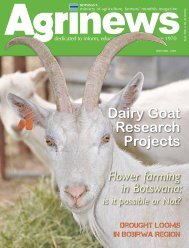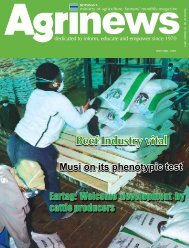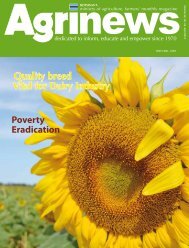Small stock farming flourishes in Kgalagadi Small stock farming ...
Small stock farming flourishes in Kgalagadi Small stock farming ...
Small stock farming flourishes in Kgalagadi Small stock farming ...
- No tags were found...
You also want an ePaper? Increase the reach of your titles
YUMPU automatically turns print PDFs into web optimized ePapers that Google loves.
<strong>Small</strong> <strong>stock</strong><strong>farm<strong>in</strong>g</strong><strong>flourishes</strong> <strong>in</strong>kgalagadiArticle: Kesegofetse TawelePhotos: Aggripah WillieItumeleng Lesesere ventured <strong>in</strong>tosmall<strong>stock</strong> <strong>farm<strong>in</strong>g</strong> <strong>in</strong> 1989 whilework<strong>in</strong>g <strong>in</strong> Lobatse. He bought hissmall<strong>stock</strong> one by one on monthlybasis. But as fate may have it, his goatstrespassed to Namibia and were neverrecovered. He, however, did not loseheart and started buy<strong>in</strong>g aga<strong>in</strong>. He wasblessed by his younger sibl<strong>in</strong>g withmore goats. Today, he is a successfulboerbok farmer.The man from Goodhope cattleposts <strong>in</strong> Karakubis chose to go <strong>in</strong>tocommercial small <strong>stock</strong> <strong>farm<strong>in</strong>g</strong> asthe returns are greater. Moreover,small <strong>stock</strong> concieve twice a year<strong>in</strong>creas<strong>in</strong>g chances of profit mak<strong>in</strong>g.He reveals that small <strong>stock</strong> <strong>farm<strong>in</strong>g</strong>is self susta<strong>in</strong>able as once started onecan sell a few animals to buy feeds andmedic<strong>in</strong>es. He boasts of a flock of 230goats. The price for a buck ranges fromP850 to P1000 depend<strong>in</strong>g on whethera buyer buys <strong>in</strong> bulk or not.Lesesere expla<strong>in</strong>ed that he choseboerbok because of its adaptability,its beauty (sk<strong>in</strong> colour) and it is alsoquick to ga<strong>in</strong> weight. However, a dayto day management of the flock isvery important as it determ<strong>in</strong>es the<strong>in</strong>come generated from the project. Inaddition, the flock has to be vacc<strong>in</strong>atedmore often for various diseases likepasturella and worms which areprevalent <strong>in</strong> the area. He also stressedthe importance of supplementaryfeed<strong>in</strong>g more especially to lactat<strong>in</strong>gdoes. He believes a doe should lactatefor a month and then wean <strong>in</strong> order toprepare it for the next conception. Anda farmer has to have several paddocksfor lactat<strong>in</strong>g does, for bucks, and forfeed<strong>in</strong>g. Kids have to be kept and fedseparately to avoid stamp<strong>in</strong>g by olderones.Lesesere lamented failure byLive<strong>stock</strong> Advisory Centre’s (LAC) to<strong>stock</strong> various feeds and medic<strong>in</strong>es. Hethus has to travel to Namibia to buythem. He also decried lack of marketfor small <strong>stock</strong>. He pleads with thegovernment to open an abattoir forsmall <strong>stock</strong> or for Botswana MeatCommission (BMC) to start buy<strong>in</strong>gfrom them. He says it is very expensiveto transport goats to Ghanzi. Healso stressed that as a bus<strong>in</strong>ess it isimportant to make bulk sales to ensurecont<strong>in</strong>uity of the bus<strong>in</strong>ess.Mr Thabo Kusane, ScientificOfficer <strong>in</strong> the M<strong>in</strong>istry of Agricultureadmitted that pasturella (Bolwetse jamadi) is prevalent <strong>in</strong> <strong>Kgalagadi</strong> areaand is seasonal. He therefore advisedfarmers to vacc<strong>in</strong>ate more often aseven vacc<strong>in</strong>ation does not guarantee100% prevention. He expla<strong>in</strong>edthat pasturella has no symptomsand usually attacks an animal whilesleep<strong>in</strong>g. He, however regretted thatthis disease is not provided for bythe government vacc<strong>in</strong>ation scheme.Therefore farmers are encouraged tobuy medic<strong>in</strong>es and ask the Veter<strong>in</strong>aryofficers to vacc<strong>in</strong>ate for them. Healso encouraged farmers to vacc<strong>in</strong>ateaga<strong>in</strong>st worms as they can causeabortion and acute loss of weight(Mmopamo).Itumeleng LesesereAugust 2012 4
the LimitwanesArticlescale of the company is determ<strong>in</strong>ed by is manag<strong>in</strong>g production <strong>in</strong> the company.profit brackets. The company currently Abidile further accredited their successsupplies Spar, various lodges and the to the team spirit that she and hergeneral public <strong>in</strong> Kasane with vegetables. husband has.It has created employment for eight “In spite of different strengths andpeople with the exception of directors. skills we br<strong>in</strong>g to the company weAbie’s Vegetable Garden produces work together a lot. We get <strong>in</strong> the fieldseasonal vegetables all year round. She and work with our staff. If you see ussaid from March to July they plant and work <strong>in</strong> overalls you will not be able toharvest leafy vegetables because there recognize us.”are less <strong>in</strong>sects that eat such vegetables With so much done and achieved,at the time. Dur<strong>in</strong>g the hotter monthsfrom August to December, they plantmelons and butternuts which do betterdur<strong>in</strong>g that period. The rest of the monthsare then dedicated to dry land <strong>farm<strong>in</strong>g</strong>.Abidile said even though they enjoyso many successes, there still do nothave mach<strong>in</strong>ery. Besides, the boreholeand the irrigation spr<strong>in</strong>kler they usehands to plant. However, she takespride <strong>in</strong> that they do an efficient workas mach<strong>in</strong>ery can do with bare hands.“We know what is necessary forplants to grow healthy. We use handsto do most processes that are known tobe done with implements. For <strong>in</strong>stance,we make ridges like a tractor with ourhands when plant<strong>in</strong>g.”To make production natural andcheaper, the Nkwanes use cow manurewhich they scout around their field.Besides, Abidile expla<strong>in</strong>ed that the blackcotton soil they plant on is rich and doesnot need a lot of fertilizers.Just like <strong>in</strong> any organization, theNkwanes have different roles that aredependant on each other and overlap.Abigal with experience <strong>in</strong> Adm<strong>in</strong>istrationand a diploma <strong>in</strong> Public Adm<strong>in</strong>istrationand Management does more of theadm<strong>in</strong>istration of the company. WhileJoseph a retired Police Super<strong>in</strong>tendent& Photos: Keamogetse Boitshepothe Nkwanes say the sky is the limitas they still have aspirations to buildtheir company to be among majorvegetable suppliers <strong>in</strong> Botswana. Theyuse shows and field days to networkand benchmark with other farmers.Their near future plans <strong>in</strong>clude rid<strong>in</strong>gon a new wave of agricultural f<strong>in</strong>ancialassistance that commercial banks areoffer<strong>in</strong>g, to reach the next milestone oftheir agricultural dream.7August 2012
77.8.9.10.11.101199August 2012
AGRICULTURAL SERVICESUPPORT PROJECT (ASSP)The M<strong>in</strong>istry of Agriculture istirelessly research<strong>in</strong>g andstrategiz<strong>in</strong>g ways to improvethe agricultural sector, henceimprove food security at alllevels. Keamogetse Boitshepo istalk<strong>in</strong>g to the Project Manager,Agricultural Service SupportProject (ASSP), Ms IkgopolengDaisy Thamae about one of therecently launched assistanceprojects.1. W h a t i s AgriculturalService Support Project (ASSP)?ASSP is a five year pilot projectdesigned to enhance theproductivity of ra<strong>in</strong> fedagriculture through use ofi m p r o v e d a g r i c u l t u r a ltechnologies, lower cost farmmechanization and developa viable model for smallholderirrigation us<strong>in</strong>g waste waterresources.2. W h a t n e c e s s i t a t e destablish<strong>in</strong>g of this Project?The need to reduce ruralpovertyLow yield productionHeavy dependency on foodimportsH e a v y d e p e n d e n c yo n s u b s i d i e s w h i c h a r eunsusta<strong>in</strong>able <strong>in</strong> the long run.3. What ma<strong>in</strong> challengesis the Project attempt<strong>in</strong>g tosolve?To reduce dependencyon subsidies and welfaremeasures <strong>in</strong> the agriculturalsector.Low technology adoption andresultant low yields.4. Which group is the projecttarget<strong>in</strong>g and why?S m a l l h o l d e r h o u s e h o l d sexperienc<strong>in</strong>g household foodand <strong>in</strong>come <strong>in</strong>security5. W h i c h d e v e l o p m e n tstrategies and policies doesthe project relate with?.Vision 2016.NDP 10. T h e N a t i o n a l P o l i c y o nAgricultural Development.The National Food Security.The Rural Development Policy.The Revised National Strategyfor Poverty Reduction.The Agricultural Sector GenderPolicy.The National Policy on Women<strong>in</strong> Development.The National Master Plan forWastewater and Sanitation6. There seem to be arelation between ISPAAD andASSP. What is the relation?ASSP complements ISPAAD<strong>in</strong> terms of implementation<strong>in</strong> order to refocus ISPAADso that it could become amore effective <strong>in</strong>strument <strong>in</strong><strong>in</strong>fluenc<strong>in</strong>g improved results(yields). It does this throughpromot<strong>in</strong>g “improved <strong>farm<strong>in</strong>g</strong>”amongst smallholders as wellas forg<strong>in</strong>g close partnershipwith key stakeholders tosupport smallholders <strong>in</strong> orderto make the objective of foodsecurity possible.7. How and when is theProject planned to roll out?Project roll out will be throughdistricts consultative meet<strong>in</strong>gs,districts startup workshops andstakeholder consultations. ASSPwill first pilot its <strong>in</strong>terventionsat Parakarungu, Tonotaand Jwaneng AgriculturalService Centers as prioritizedunder ISPAAD. The projectcommenced on April 2012.8. Who is fund<strong>in</strong>g the Project?Government of Botswanaand the International Fundfor Agricultural Development(IFAD)9. When is the Projectexpected to end?31 st March 2017.10. Any other <strong>in</strong>formation?ASSP: Promot<strong>in</strong>g Susta<strong>in</strong>able<strong>Small</strong>holder AgriculturalProduction.T h e T h e m e f o r 2 0 1 2 - 1 3Plan is “Rais<strong>in</strong>g Awarenessand Mobiliz<strong>in</strong>g for ASSPImplementation.”August 2012 10
Ostriches have aArticle: Keamogetse BoitshepoPhoto: Aggripah WillieDibete Ostrich MultiplicationUnit (DOMU) is a home formore than 1000 ostrichescompris<strong>in</strong>g of South African Blacksand <strong>Kgalagadi</strong> Blue breeds. The unitwas established by the M<strong>in</strong>istry ofAgriculture as a catalyst to revive theostrich <strong>in</strong>dustry <strong>in</strong> Botswana.Dur<strong>in</strong>g the Agr<strong>in</strong>ews’ visit tothe farm, it became evident thatthese birds enjoy human company.When they saw our vehicle, they ranalong the paddock fence seem<strong>in</strong>glyto rac<strong>in</strong>g aga<strong>in</strong>st it. Unfortunately,they lost the race at the fence thatdivides the paddock, where anotherbatch takes over <strong>in</strong> the next paddock.When the vehicle stopped the birdsgathered attempt<strong>in</strong>g to have physicalcontact.540 of the ostrich population <strong>in</strong>the DOMU farm are the breederbirds compris<strong>in</strong>g of 206 males and334 females. For breed<strong>in</strong>g purposes,the birds are grouped <strong>in</strong> differentpaddocks.“A paddock for breeder birds has12 resident birds all together, madeup of eight females and four males.Ostriches commit to relationships,often one cock mate with two tothree hens. But <strong>in</strong> DOMU, we usea ration of 1:2,” said Mr ThebeyameEole, Scientific Officer.Eole said the ostriches naturallyform groups and are territorial hencecreate unmarked territories with<strong>in</strong>the paddocks.Most of the breed<strong>in</strong>g birds, Eolenoted, are more than 30 years of ageand are still on the prime of theirfertility. He said ostriches stay fertilefor the longest time of their life spans<strong>in</strong>ce they can breed until they arearound 80 years of age.“The female ostriches are readyto start breed<strong>in</strong>g at 12 months whilemale ones start breed<strong>in</strong>g at threeyears.”For bus<strong>in</strong>ess purposes, Eoleasserted that it is imperative to studyOstrich birdsAugust 2012 12
Promis<strong>in</strong>g Futurethe fertility rate of each bird andremove those that do not produceaccord<strong>in</strong>gly.Like other animals, ostriches havecerta<strong>in</strong> behaviours and body changeswhen they are on heat. Eole said thefemales tend to raffle their featherswhile their male counterparts’ legcolor turns reddish and prepare anest for eggs.The Farm Manager, Mr HarryJohnson said an ostrich female birdhas a potential to produce 38 eggsper production season. Johnson saidthe farm has a potential to produce8 000 hatch<strong>in</strong>g eggs per breed<strong>in</strong>gseason which spreads through Mayto December each year.However, he said the farmcurrently produces between fourand five thousand eggs becauseof controlled breed<strong>in</strong>g due to theclosure of the abattoir.E v e n t h o u g h t h e f a r mhas deliberately reduced theirproduction rate, the preparationsto fulfill their mandate of effectivelymultiply<strong>in</strong>g ostriches are underway.At the time of the visit, theconstruction of the <strong>in</strong>cubator wasalmost complete. Johnson said the<strong>in</strong>cubator will be used to <strong>in</strong>cubateeggs hence the birds will cont<strong>in</strong>uewith breed<strong>in</strong>g.“Incubation of an ostrich egg takesabout 42 days so if the brood<strong>in</strong>gwas done naturally the birds willspend more time brood<strong>in</strong>g. As suchartificial brood<strong>in</strong>g relieves breed<strong>in</strong>gbirds of such responsibility henceimprov<strong>in</strong>g breed<strong>in</strong>g rate.”However, Johnson clarified thatthe unit has always outsourced<strong>in</strong>cubation services for brood<strong>in</strong>g ofeggs.Further, Johnson said the chicksare sold when they are between 10and 12 months to licensed ostrichfarmers. This, he said, is to ensurethat buyers have conducive farmsfor the birds.Thebeyame Eole13August 2012
Desperatetimes turnopportunitiesArticle: Kesegofetse TawelePhotos: Aggripah WillieKe o l o p i l e M o t s h a b i s e o fC h a r l e s h i l l s t a r t e d h e rbackyard garden under oddcircumstances.Those odd circumstances turnedbreakthroughs to her life. All started<strong>in</strong> 2003 when she fell very sick andcould not walk.She was diagnosed with Gout andwas advised to eat green vegetables.Due to her health condition, sheKeolopile Motshabisestarted with two backyard gardenplots at the time and little did sheknow that those two plots marked anew lease of life.Motshabise revealed that herplots were spotted by an Agriculturaldemonstrator who advised her toexpand and helped her to preparemore plots. After she got better,horticulture became her primarysource of <strong>in</strong>come. She plantedChomolia, Sp<strong>in</strong>ach and Rape. Shesold one leaf for 25 thebe. As theAgricultural Demonstrators saw herprogress they facilitated that sheattend horticulture related courses <strong>in</strong>Francistown. Thereafter, her pric<strong>in</strong>galso improved as she started to usea scale <strong>in</strong>stead of sell<strong>in</strong>g per leaf,she sells 500grams for P4 whereas1kg costs P6.She expanded her garden and<strong>in</strong>creased varieties to <strong>in</strong>cludeEthiopian mustard, Beetroots,Tomatoes, Onions and Carrots.Motshabise expla<strong>in</strong>ed thatEthiopian mustard is preferredby most people therefore itssales are high.She re<strong>in</strong>vested some ofthe profits <strong>in</strong>to her project byfenc<strong>in</strong>g and net shad<strong>in</strong>g andbuy<strong>in</strong>g fertilizers. Motshabiseexude enthusiasm and passionwhen she talks of the developmentsshe did <strong>in</strong> her homestead with herprofits. She has electrified her housesand connected water pipe which sheuses to water her garden. She evenmanaged to pay for her children’sschool fees.When most bus<strong>in</strong>essmen andwomen strive to be the best above therest, this remarkable woman believes<strong>in</strong> healthy competition as the basisof growth. She encouraged her twochildren, one under 4B club to startsimilar projects. She also mentors oneother child whose project collapsed.“Competition encourages one to workextra hard and be more dedicatedto his or her enterprise.” This isaugmented by the awards she took atthis year’s Ghanzi show. She took twochampions for Ethiopian mustard andorange, and several first classes forother crops. Her children also provedto be on the right track as they got firstclasses as well.However, her bus<strong>in</strong>ess is faced withchallenges of its own like nematodes<strong>in</strong> the soil of which she has to travelto Maun or send people to Gaboroneto buy pesticides. She also decriedlack of transport to take her produceto the market.She expla<strong>in</strong>ed that she ga<strong>in</strong> mostsales by go<strong>in</strong>g around the villagesell<strong>in</strong>g from house to house or go<strong>in</strong>gto sell at the cl<strong>in</strong>ic where most peopleare gathered, but she has to carry herproduce <strong>in</strong> a large bowel on her head.She lamented failure by the land boardto allocate her a plot where she couldexpand her bus<strong>in</strong>ess as the space <strong>in</strong>her yard is no longer enough.August 2012 14
Gu<strong>in</strong>ea fowl farmerrema<strong>in</strong>sArticle: Segomotso BasutiPhotos: Aggripah WillieLike any other man, ThekisoMadigwe dreamt of a happylife where he would not bedependent on any one for his nextmeal. But what happens when thisdoes not come true. One may betempted to give up and watch as hispursuit of a happy life evaporatesdue to countless setbacks they f<strong>in</strong>dthemselves <strong>in</strong>. Madigwe, however,soldiers on and preaches patienceamidst tough times.It has been three years s<strong>in</strong>ce Madigweacquired Gu<strong>in</strong>ea Fowls through theLive<strong>stock</strong> Management InfrastructureDevelopment (LIMID) programme.His birds are escalat<strong>in</strong>g <strong>in</strong> numbers.Not know<strong>in</strong>g his story one would th<strong>in</strong>kbus<strong>in</strong>ess is flourish<strong>in</strong>g by look<strong>in</strong>g atthem. This is not the case as each dayhas its challenges.Problems encountered by this farmerare many to count. It is howeversooth<strong>in</strong>g to learn that he has placedoptimism above gloom. With the costof liv<strong>in</strong>g escalat<strong>in</strong>g daily, Madigwestruggles to keep his bus<strong>in</strong>ess go<strong>in</strong>g.He states that <strong>in</strong> a month there isa lot of money spent on feeds andmedic<strong>in</strong>e crippl<strong>in</strong>g him from see<strong>in</strong>ghis bus<strong>in</strong>ess grow.“Total expenses <strong>in</strong>curred <strong>in</strong> a monthare a sky rocket<strong>in</strong>g P600.00, it wouldoptimisticoptimisticbe better if I was spend<strong>in</strong>g such anamount while there is growth but thereare just too many problems here.”Diseases are also someth<strong>in</strong>g that iscaus<strong>in</strong>g havoc <strong>in</strong> Madigwe’s bird pen.He does all one could do to controlthem, but the rate at which the birdsdie is overwhelm<strong>in</strong>g.However, accord<strong>in</strong>g to Madigwe, onecould susta<strong>in</strong> their lives throughGu<strong>in</strong>ea Fowl rear<strong>in</strong>g. Witha price tag of P150.00 hebelieves if the marketwas good <strong>in</strong> his area,he would be able to putfood on his table.“The market here isa problem, but I amyet to do an <strong>in</strong>tensiveadvertis<strong>in</strong>g of mybus<strong>in</strong>ess <strong>in</strong> hotels andlodges as sell<strong>in</strong>g to<strong>in</strong>dividuals hasnot provedlucrative.”Government no longer providesassistance for Gu<strong>in</strong>ea Fowls under theLIMID programme. This Madigwe said,has been a big blow to Gu<strong>in</strong>ea Fowlfarmers as the government used tobuy from to assist other beneficiaries.With the cessation of the componentfrom the programme farmers haveto source their own market which isalready scarce.He said th<strong>in</strong>gs used to be betteras government would buyfrom him to sell to farmerswho had been funded tostart their own projectsbut times have s<strong>in</strong>cebeen tough. For farmerslike Madigwe, only hopekeeps them go<strong>in</strong>g. Thebelief that tomorrow willbe much brighter thanthe current day keepshim go<strong>in</strong>g despiteall odds.August 2012 16
TEASERSCompiledBy Segomotso BasutiDid you know?A giraffe can go without water longer than a camel.Did you know?On average, pigs live for about 15 years.Did you know?Newborn rabbits are called kittens.Did you know?No two cows have exactly the same pattern of spots.Did you know?The bright orange color of carrots tell you they’re an excellent source of Vitam<strong>in</strong> A which isimportant for good eyesight, especially at night.Did you know?You do not need cotton buds to clean a giraffe ears. It can do so with its own 50cm-tongue.Did you know?While the male lion rests <strong>in</strong> its den, it is the females that have to go out and get food.Did you know?Sheep are very social animals and live <strong>in</strong> groups called “flocks.” When faced with danger, a flockwill run together for a short distance, then turn to face the danger as a group.Did you know?Potatoes are only 20% solids…and 80% water.Did you know?An elephant trunk has no bone but 40,000 muscles.Did you know?A Tomato is versatile vegetable for cook<strong>in</strong>g. It can be prepared stuffed, baked, boiled, stewed,pickled, and fried, and are the base for many sauces.19August 2012


